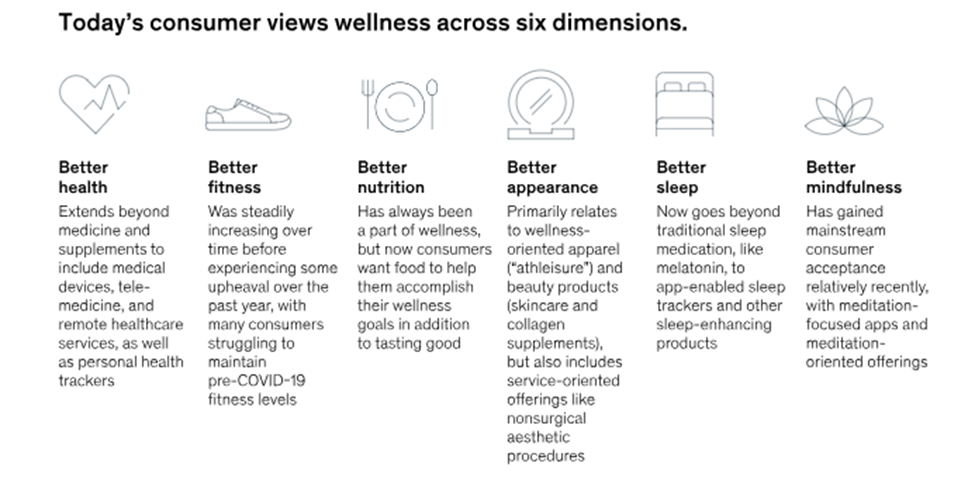The Latest Wellness Trends: What to Expect in the Health and Wellness Industry

Most people include health and wellness goals in their New Year’s resolutions, so it’s a perfect time for organizations to tune in and take advantage of the opportunity to improve wellness programs for their employees.
The wellness market is booming, and 2024 promises to bring a wave of trends that focus not only on physical health, but also on mental well-being and sustainability. According to one McKinsey report, this $15 trillion industry encompasses many focus areas, from nutrition and fitness to mental health practices such as mindfulness. Most of them offer numerous benefits when applied to the workplace.

In this blog post, we'll explore the top wellness trends expected to dominate the health and wellness industry in the new year and see how they intersect with the workplace and wellness programs. From increasing diversity in personal diets to the rise of mental health awareness and the adoption of mindful movement practices, we'll discuss the key trends that will shape our wellness journeys in 2024.
1. Working Towards Healthier Nutrition in the Workplace
In recent years, there has been a noticeable improvement in nutrition alternatives in the workplace. With many organizations offering lunch and snack options for workers, it’s becoming more common for this perk to be connected with a wellness initiative. Many businesses are adopting wellness programs that include healthier meals, offering plant-based, reduced-sodium, and low-fat options. This translates into healthier staff and reduced absenteeism.
Personalized nutrition plans are another developing trend. Gone are the days of one-size-fits-all diets. In the coming year, there will be a greater focus on personalized nutrition, with individuals seeking diets that align with their specific health goals, preferences, and requirements. Some workplace wellness programs are starting to offer tailored nutrition plans for employees with specific needs. Advances in technology, such as genetic testing and health monitoring, are making it easier for people to understand their unique dietary challenges and nutritional requirements. The global personalized nutrition market size is projected to reach $37.3 billion by 2030, growing at a CAGR of 11.48%.
How Do Personalized Nutrition Programs Work?
Registered nutrition professionals usually consider a patient’s lifestyle, dietary habits, and physical activity while designing a nutritional program. However, we know that not every diet works the same for every person, so personalized nutrition goes a step further by doing tests and thoroughly assessing how food and nutrients affect a specific person’s biology, thus indicating their personal nutrition needs.
Applying Personalized Nutrition to Workplace Wellness Programs
Building personalized nutrition plans as part of a workplace wellness program has several benefits for both employees and organizations, but it also has downsides. Here are some considerations.
Benefits
- Personalized nutrition plans can be perceived as valued perks as part of a work wellness plan.
- Employees may benefit from deep insights about their nutritional needs, which may help them know what steps to take to prevent common issues such as diabetes and cardiovascular disease.
- Healthier employees mean reduced absenteeism and sick leave — and increased engagement and work satisfaction.
Drawbacks
- It may take a long time and several adjustments to get the right plan for an individual.
- Patients may not be consistent in documenting what they eat and drink, which can affect the assessment.
2. Mental Health: Breaking the Stigma and Prioritizing Emotional Well-Being
In 2024, the conversation around mental health is set to become even more prominent. Breaking free from the stigma associated with mental health challenges, people are recognizing the importance of prioritizing emotional well-being.
Workplace Initiatives to Destigmatize Mental Health Issues Are Becoming More Popular
Management and senior executives are finding ways to normalize the conversation and build mental health awareness in the workplace by:
- Designing and committing to a mental health policy: In an Aflac Report for 2023, although nearly 80% of employees agreed that mental health coverage is essential, only 61% had access to it in their benefits package.
- Offering employees workplace adjustments: This could include allowing them to take a mental health day.
- Encouraging conversation about mental health topics: Leaders and top executives can lead by example on this.
Technology Supporting Mental Health via Software Apps
In the aftermath of the pandemic, organizations started using software applications to help employees manage their mental health. Apps can support prevention initiatives and help employees access stress management mechanisms — and even online therapy.
Popular applications focus on reducing stress, improving focus, and encouraging healthy habits. Most of them include guided meditation practices, and some include corporate wellness recommendations and behavior analytics for organizations.
3. Mindful Movement: Embracing Holistic Fitness Practices for a Balanced Lifestyle
High-intensity workouts are giving way to a more holistic approach to fitness. Mindful movement, including yoga, Pilates, and tai chi, is gaining traction as people seek a more balanced and sustainable approach to physical activity.
Types of Exercises and Activities That Promote Mindfulness at Work
Organizations may include practices such as guided meditation groups, yoga sessions, and mindfulness apps to help employees manage stress. These initiatives can help employees be aware of their stress triggers and give them tips on how to cope with stressful situations. Calm employees are happier and more productive, and studies show that these initiatives may result in reduced burnout and increased employee satisfaction.
4. Digital Detox and Sleep Optimization: Prioritizing Rest in a Hyperconnected World
In this age of constant connectivity, there’s a growing awareness of the need to unplug and prioritize quality sleep. The new year is expected to see an increased emphasis on digital detox practices, with individuals consciously taking breaks from screens to improve sleep quality and overall well-being.
Digital detox practices include staying away from connected devices, such as computers and smartphones, for a designated period of time. Every individual or organization can choose their version of digital detox, from staying off social media to disconnecting from devices on the weekends. Workplace digital detox weekends and retreats have become more popular in recent years, and organizations often host events to help employees relieve stress by unplugging.
As people recognize the impact of adequate rest on their physical and mental health, they experience a cultural shift towards valuing and prioritizing rest. Sleep optimization, including adopting sleep-tracking technology and establishing healthy bedtime routines, is becoming integral to wellness routines.
5. Using Innovative Technology to Power Wellness Programs
Advances in data analytics and AI-powered tools are leading to more alternatives to engaging employees in wellness programs. Technology can help encourage employees to invest in their health.
Wearable technology is one trend to keep an eye on, as it allows employees to monitor their health goals and fitness levels. Gamification and personalized well-being challenges can also drive employees’ engagement with a wellness program.
Learn how you can leverage our optimized tech solutions designed to support the health journeys of your employees
CoreHealth's corporate wellness platform is an all-in-one solution completely customizable to your organization’s needs. Design and deliver wellness programs tailored to your workforce with our innovative features, including gamification through well-being challenges, progression maps, message boards, self-paced digital micro-learning programs, and a comprehensive virtual health assessment. Social and mental health support with group and buddy chats, advanced communication tools, and event scheduling can help prevent isolation and burnout. Discover how our platform and tools can help elevate your wellness program.
Contact us to speak with one of our experts today!
Learn more about wellness trends in the following articles:
About The Author
CoreHealth Marketing
CoreHealth Technologies Inc. is a total well-being technology company trusted by global providers to power their health and wellness programs. Our wellness portals help maximize health, engagement, and productivity for 3+ million employees worldwide.



